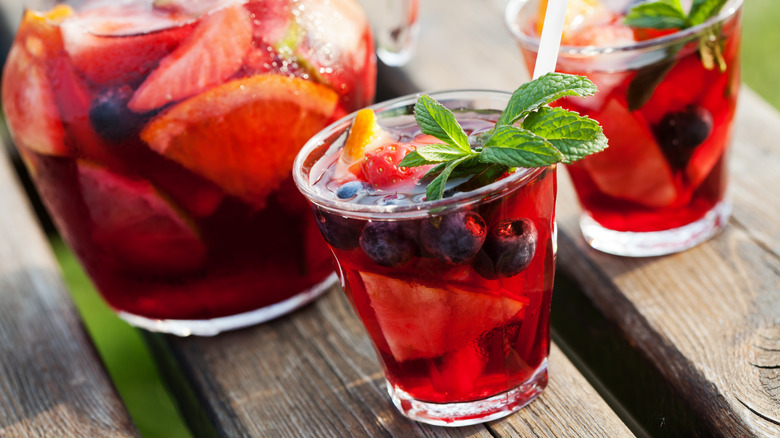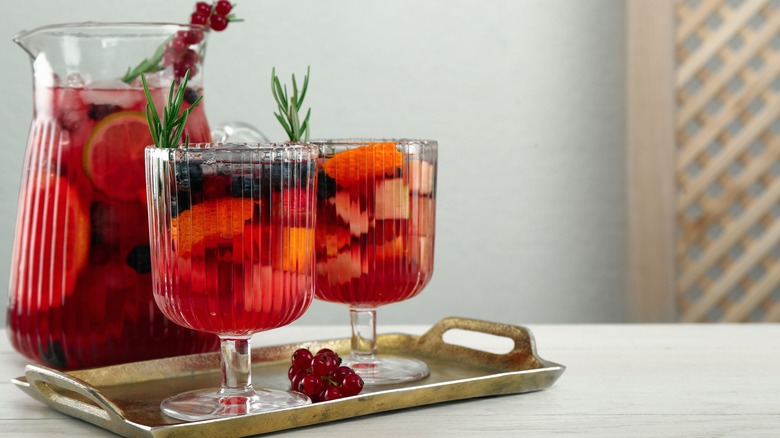Fresh Herbs Are The Secret To Perfect Summer Sangria
A pitcher of fruity sangria on a hot day is equally tasty as it is refreshing. The beauty of this wine-based beverage is how easy it is to make your own simply by mixing and matching the wine and fruit of your choice, but if you really want to separate your sangria from all the others, try using fresh herbs. These little green leaves can enhance the overall flavor of this punchy drink, and depending on what you choose to add, infusing herbs into your sangria can help reign in overly sweet or bitter tastes. They can also add a little bit of a spicy kick to your boozy drink. But before you start tearing off leaves of mint, basil, thyme, and the like, it is important to be thoughtful and choose the right herbs.
Herbs fall into two categories: Soft and hard, but which is which? If you pay attention, they are pretty easy to keep straight; soft herbs have soft leaves, and hard herbs have a woody stem and firm leaves. For example, soft herbs include basil and dill, while hard herbs claim rosemary and thyme. As a general (but not hard and fast) rule, soft herbs pair well with white wines, while woody herbs will jive better with your reds because they tend to have more earthy notes.
Choosing your herbs
When thinking about which herbs to add to your sangria, consider your wine's overall profile, tasting notes, and the fruits you use to create your sangria. You want to complement and round out all the various taste elements. For example, sweet and pungent basil leaves can add peppery notes to a white sangria made with a sauvignon blanc or even a rosé, but this herb can also work with a red sangria. That said, because red wines tend to skew bolder in flavor, it's worth experimenting with holy basil, which will give you more peppery notes with a touch of licorice. This herb couples well with blueberries and citrus. All you need is 8 to 10 leaves per bottle of wine to taste the difference, and you can add it in when you add whatever fruits you plan on using.
Are you having a Mexican fiesta by the pool? Cilantro will add a slight heat to your citrusy white sangria and is perfect when using lemons and limes as your fruity element. Because cilantro leaves are more delicate, you will want to add more. Adding ½-1 cup of cilantro is all you need to impart its flavor to your sangria. Remember, the longer your sangria sits in the fridge, the more flavorful it will become as the herbs infuse the wine.
Herby combinations
You can also infuse your wine with an herby element by creating a simple syrup using your favorite herb combination. Lavender and mint are both aromatic, but infusing sugar water with the two creates a lovely sweet, floral, simple syrup that you can add to your sangria. After steeping the magic of your herbs into a simple syrup, you will want to add about one tablespoon of your sweetener to each 5-ounce serving of white sangria. It will keep for anywhere from a week to 10 days.
If you are mixing up a pitcher of sweet red or white sangria, consider adding fresh rosemary sprigs. Rosemary is a very wine-friendly herb and works in any type of sangria. Its woodsy and lemony notes pair perfectly with whatever fruity elements you might have on hand, and it also adds a lovely fragrance. Rosemary's superpower is that it will offset the sweetness and balance the flavor of your sangria.
Another herb that can amp up the flavor of your red sangria is sage. Sage is often associated with fall foods like Thanksgiving day stuffing, but it can add an earthy, savory layer to a red sangria, especially one that uses rich, dark berries that can match its taste. This combination is perfect if you use a shiraz or pinot noir for your sangria. But just remember, sangria is all about ease and experimenting until you find the fruits, wines, and herbs that work best for you.


